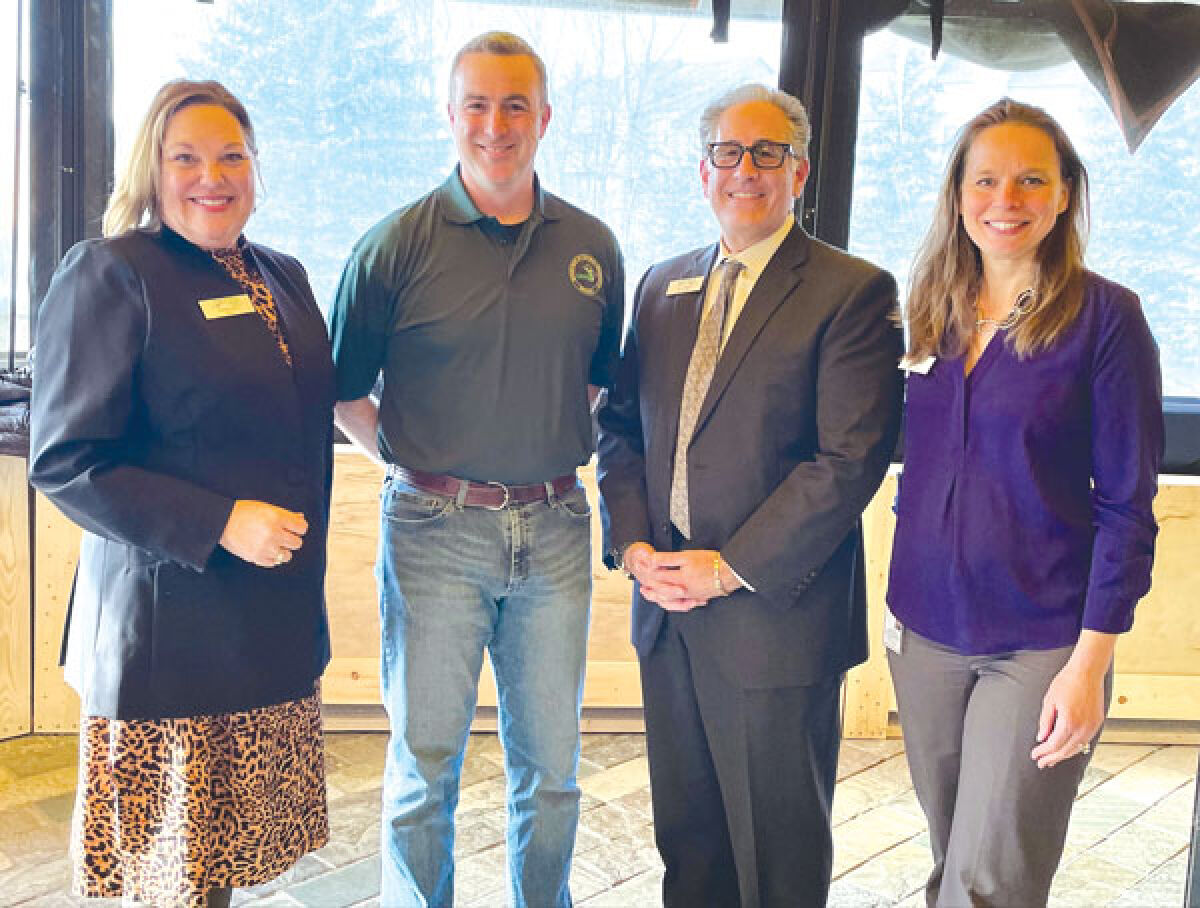METRO DETROIT — Although most cities and townships have their own unique agendas to tend to, in recent years a common issue has captured the attention of multiple municipalities.
For some, deer sightings are perhaps mostly associated with areas in the northern part of the state, but residents in some local communities know that you don’t have to take an hours-long car ride to get a glimpse of the graceful wild animals. They can be spotted in yards of many Oakland County homes.
For some, that brings joy. For others, it’s a nuisance, and a potentially dangerous one at that.
The issue is one that recently brought local community leaders together.
Last month, the city of Farmington Hills hosted a meeting of the South Oakland County Mayors Association, and a regional approach to urban deer herd management was a topic of discussion.
At a goals study session in January, the Farmington Hills City Council set a goal to work toward creating a systematic solution “to an ongoing concern,” according to a press release.
Farmington Hills Mayor Theresa Rich, along with City Manager Gary Mekjian and members of Farmington Hills City Council, were part of the meeting.
Other attendees included representatives from Berkley, Birmingham, Farmington, Ferndale, Hazel Park, Madison Heights, Novi, Southfield, Troy, Northville, Wixom and Oakland County.
The keynote speaker at the meeting was Chad Stewart, who is a deer, elk and moose management specialist with the Michigan Department of Natural Resources.
Some communities are part of the Southeast Michigan Urban Deer Coalition, which was formed in 2021 as the Oakland County Community Deer Coalition.
“Once a month, the mayors of south Oakland County get together and talk about issues that cut across our various cities, and March was Farmington Hills’ turn to host, and we saw this as an opportunity to bring together regional leaders from numerous cities across the county so that we could all hear from the Michigan Department of Natural Resources’ expert at the same time, because the reality is we all have an issue with the urban deer herd,” Rich said. “So far, I think, there’s been little collaborative regional action that’s been taken to manage the urban deer herd. What we know is that if we’re going to have a lasting impact, we’re going to have to work together on this very important safety issue.”
According to the Humane Society’s website, deer thrive in human-shaped habitats such as the edges of roadways, forests, parks and suburban yards, and the development of woods and open space has forced them into close contact with people.
Aside from the frustrations some residents have with deer damaging their gardens, more serious concerns include deer-vehicle collisions and the fear that their presence could cause Lyme disease. According to the Centers for Disease Control and Prevention, deer “are important sources of blood for ticks and are important to tick survival and movement to new areas. However, deer are not infected with Lyme disease bacteria and do not infect ticks.”
Strategies for how to manage the deer population vary, with some advocating for nonlethal solutions and others preferring a lethal way of dealing with the issue.
A few of the nonlethal suggestions that have been put forth include trapping deer and relocating them to a northern part of the state, lacing food with contraceptives so that female deer cannot become impregnated, and putting fencing around yards.
Trap and transfer
Rich addressed the possibility of relocating deer.
“That seems like a great, humane way of handling it, but the reality is that deer are a very anxious animal, and so, when we relocate them, I’m told the majority of them die because of the anxiety of the move, or they’re taken to a place that they’re not imprinted – they don’t know where to gather food, where to sleep, what’s safe, what’s not safe, as opposed to where they grew up,” she said. “And so, while that may seem like a great option, it really isn’t.”
Trapping and relocating deer is not an option that is endorsed by the DNR.
“That is something that is not going to be authorized or permitted just because there’s a lot of stress involved with capturing deer,” Stewart said. “Where would you take those deer? And the likely survival of those deer is often very poor. They often succumb to some sort of environmental condition shortly after release.”
Attending the meeting helped Farmington Mayor Pro Tem Johnna Balk gain an understanding of why relocating deer may not be a feasible option.
“As far as transporting deer say, Up North, it’s very traumatic for the deer, and they would not survive,” Balk said. “If you have an urban deer or suburban deer, they’re not going to know what to do with 4 feet of snow regularly in the U.P. So, it would be cruel to do that kind of thing, and I thought that was rather eye-opening, because I would not have known that.”
Contraception and containment
The idea of utilizing contraceptives is also one that is not supported by the DNR.
“The other thing that is oftentimes brought up is this idea of contraception, and contraception is not permitted,” Stewart said. “There’s only two types of federally registered drugs. They’re actually registered as pesticides in the country, neither of which have been approved for use in Michigan, so that’s also not an option moving forward.”
As for the idea of employing fencing to keep deer off of properties, according to Stewart, due to their powerful legs, it would be easy for them to clear a fence even as tall as 8 feet high.
“Anything less than that is just like you or I jumping over a stick on the ground,” Stewart said. “They’re very strong and very powerful, so you need a fence that really needs to be about, probably closer to 10 feet in height before you start to get true exclusion. So yes, it’s a possibility, but in a lot of these communities there’s sort of an aesthetic value that goes along with neighborhoods and properties, and that’s something communities are considering, is that nobody really wants to put everybody’s own front yard, backyard, behind a 10-foot fence. It almost feels like you’re in individual cell blocks at that time.”
Lethal options
Lethal options for managing the deer population are managed hunts and a cull, which is a practice designed to control wildlife population.
“When you start talking about what can actually address populations, it almost always comes back to one of two options, and that is some type of managed hunt or what we call culling, which is done by trained professionals that go in and very quickly and effectively remove deer, but it’s expensive,” Stewart said. “Those individuals just don’t grow on trees. There are only a select few groups and organizations that do that.”
Although Stewart said that the cost varies, he added that, “I think it’s probably anywhere between $100 and $200 a deer in many instances, and that could be a little bit higher, it could be a little bit lower, depending on the situation.”
From the perspective of West Bloomfield Township Supervisor Steven Kaplan, when it comes to deer, residents are split between “leave them be or extinguish them.”
He is also a proponent of trying to identify a regional solution.
“When a deer crosses 14 Mile heading northbound from Farmington Hills, the deer doesn’t distinguish between boundaries,” Kaplan said. “We’re a team on this, because if they decide to cull and they do so successfully over a three-year period and we don’t, well the deer will start gravitating toward Farmington Hills.”
Kaplan shared one option for attempting to manage the deer population that he is ruling out.
“I’m opposed to assigning our police officers to the woods and other areas where the deer populate,” he said. “We’re not (going to) spend taxpayer dollars on having our police officers shoot deer.”
Aside from expense, there is another potential issue with the idea of having a deer cull.
“The first year that happened we would expect to see more babies,” Rich said. “If there was a cull, a one-time cull, what we’re told is that the deer sense that the herd size has gone down and so they will act to bring back up the size of the herd, and so they will have more multiple babies. So rather than deer just having one fawn, they might have two, or sometimes … they might even have three.”
Environmental impacts and deterring deer
Another complaint about deer is that they damage forests and reduce biodiversity.
However, the Humane Society’s website states that deer are “scapegoats” for larger ecological problems of biodiversity loss and forest-growth failures.
“Notions of overpopulation, or how many deer are too many for a given area, are subjective,” the site states. “It may be true that deer densities are at historic highs, but the forests of today in no way represent historical conditions. Urbanization has created an abundance of edge habitat, which is ideal for browsing deer. Deer have simply adjusted their populations to available resources.”
When it comes to deer population, Kaplan is of the opinion that there is no cure-all solution. However, he shared what he is a proponent of.
“We urge residents not to feed the deer,” Kaplan said. “Don’t leave food scraps and other food for the deer. … They’ll remember and they’ll revisit. Theoretically, if West Bloomfield residents do not feed the deer, many of the deer would find another haven.”
Stewart said that there are “huge” benefits to not feeding deer, and added that there is a state law that prohibits it.
“It is illegal to bait and feed deer anywhere in the lower peninsula of Michigan,” Stewart said. “So communities don’t even have to develop that ordinance. It’s already existing at the state level.”
Although the Humane Society’s website states that the key to success is for residents to understand that deer are here to stay, a “deer-proofing” strategy was offered.
“Certain plants like tulips and hostas are irresistible to deer,” the site states. “Even if the deer population could be greatly reduced, these favorite flowers would still be eaten by any remaining deer. Effective solutions focus on deterring deer and protecting flowers and ornaments. … Choose plants deer generally don’t like, such as daffodils and irises, boxwood and pachysandra.”
By the numbers
According to Stewart, deer population estimates are difficult to obtain, and “that’s not something we even have.”
However, Rich said that an aerial survey in 2019 showed 370 deer in Farmington Hills. When another survey was conducted in 2021, she said, the population had risen to 729.
Perhaps the biggest concern about a high deer population for some residents is the possibility of deer-vehicle collisions.
According to michigantrafficcrashfacts.org, motorists in Michigan reported 58,894 vehicle-deer crashes in 2022, resulting in 1,633 people being injured and 11 people being killed.
Of the 11 people who were killed, six were reported to be motorcycle riders.
The site states that vehicle-deer crashes occurred most often in Michigan’s heavily populated southern counties.
That year, Kent County had the most with 2,250, followed by Oakland County, which reported 2,009 vehicle-deer crashes.
According to the Humane Society, studies have shown that reducing the deer population doesn’t necessarily reduce the number of collisions.
“Many factors contribute to deer-vehicle collisions, such as traffic volume, speed limits, the extent to which roads bisect habitats and migration routes and the use of visual barriers,” the site states.
To avoid hitting an animal with a vehicle, the Humane Society suggests following speed limits, watching for wildlife in and near the road at dawn and dusk and in the first few hours after darkness, exercising caution on two-lane roads bordered by woods or fields or where streams cross under roads, watching edges for wildlife about to cross, not throwing trash out of car windows, and lowering dashboard lights slightly — headlights reflected in the eyes of animals can help drivers brake in time.
The Humane Society’s website also states that scientific studies have shown that killing deer won’t reduce people’s risk of contracting Lyme disease.
“Deer kills do not significantly reduce the population of the tick that spreads the disease – the black-legged tick (or deer tick), which feeds on almost all mammals, most songbirds and even lizards,” the site states. “In Great Island, Mass., when up to 70% of the deer were removed, there was no marked reduction in tick abundance. Where deer are scarce, ticks switch to other hosts or congregate in higher numbers on the remaining deer.”
Although Rich said that there will probably be some sort of action taken, she is not expecting an immediate solution.
“Anything that we would be organizing would require DNR approval and collaboration with the various governments, and so I think that is something that will be, probably, years in the making for action to actually happen,” she said. “I am optimistic that we all recognize that the No. 1 job of government is to keep people safe, and so if this is truly a safety issue, and we have some people who believe it is and some people who believe it is not, let’s get the data and let that drive what our actions are going to be.”
From Balk’s perspective, it was helpful to have DNR input on what she said is the information-seeking phase of the process.
She understands that the conversation surrounding deer management solutions is a “very tender and emotionally charged topic.”
“I just know that we all have to work together as communities in order for it to be effective, and information has to be the main thing, because you have to get the public to understand what the situation is,” Balk said. “There has to be collaboration. We, as Farmington, can’t just decide to do something, because we’re surrounded by Farmington Hills. So whatever we do or they do directly impacts the other.”
Kaplan said that “we might be able to reduce the deer population, but not eliminate it.”
Stewart shared a similar sentiment and said, “you will never fully eliminate your potential for a collision with a deer.”
“Unfortunately, there’s no such thing as a cheap, effective and fast deer-management tool that is completely supported by members in their community,” he said. “I don’t think that there is one golden solution that all communities can just simply implement and their problems are going to go away. … There is some component or some level of living with deer. It’s just, I think, most people are willing to live with less deer than what they’re currently experiencing.”
 Publication select ▼
Publication select ▼























